When 100-to 200-yard shooting doesn’t seem too challenging anymore, you know it’s time to up your game! With the right knowledge and gear, long-range shooting is actually a lot of fun.
You’ll need some patience to get to that level but you’ll know it’s worth the effort when you’ll be accurately placing a bullet at a half-mile plus!
A quality scope is a must to master the art of long-range shooting but what features to look for? How to find out the most reliable scopes in different price ranges? We’re here to help just with that!
This article will provide unbiased reviews of the best long range scopes that you can use for up to 1000 yards. We’ll also talk about how you can choose the perfect one for you, and what to expect when selecting the best scope for 1000 yards. Let’s jump right in!
Our Reviewed Best Scope for 1000 Yards
1 Vortex Optics Strike Eagle Second Focal Plane
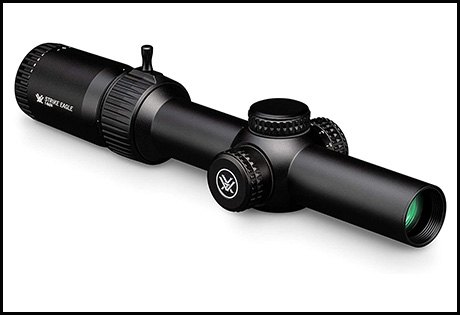
Vortex Optics is a household brand for most marksmen and rifle users around the country, and there are good reasons for that. They’ve been maintaining high standards for their optics in terms of lens quality, build, adjustability and precision.
Categorically, the Strike Eagle is a variable scope that travels from 4 to 24x. It falls into the second focal plane category. Built of a 30mm tube, it sports multi-coated lenses that means wonderful clarity even when the exit pupil is minimum at max magnification. The eyepiece is a fast focus one.
The Strike Eagle has a side parallax adjustment. This is on the same turret as the intensity adjustment of the illumination. Parallax optical effects that can lead to view inconsistencies are wiped off.
The EBR-4 reticle is cool. It has 11 different settings for illumination. Even the lowest setting is visible to the naked eye. Using MOA for both reticle and turrets allows you to just hold over or with the turrets, adjust elevation and windage.
The magnification can be raised by attaching an add-on, for example, the Vortex Swichview SV-4 Throw Lever. Although the performance gets a little nerfed in long ranges, when it comes to features and performance, this really is the best scope for 500 yards.
On the down side, mounting is not provided and the caps are flimsy. Though the eye relief is sufficient, the eye box is somewhat tight. The crosshair is more accurate but we found the dot easier to use.
Priced at $300 to a shade under $600, this is a cool deal. The customer service is exceptionally well. A Vortex lifetime guarantee is offered for the scope which is also great.
The horseshoe reticle is designed well and helps in different shooting situations. We were a bit dissatisfied with the quality of the glass. The field of view was 20% larger than other traditional scopes.
The Strike Eagle and the Viper PST both are from Vortex. Features are nearly identical. The Strike Eagle outperforms the PST for long-range shots whereas the PST is more suited for mid and short-range shooting.
The major difference is in the optics quality and coatings where the PST creeps ahead. When it comes to a budget, the PST is 50% higher in price.
Specifications
- Magnification: 1-6x
- Objective: 24mm
- Length: 10.5 inches
- Weight: 17.6 oz.
- Adjustment click value: ½ MOA
- Eye Relief: 3.5 inches
- Parallax: 100 yards
- Reticle: AR-BDC
Pros
- Quick and easy focussing
- Reticle marking improves shooting accuracy
- Ultra-low dispersion optics increases color reliability
- Thick anti-reflective layer disguises the shooter
- Parallax adjustment easily accessible
Cons
- Caps are flimsy
Our Verdict
The Strike Eagle is an unmatched reasonably priced flexible optic. The new lens gives an advanced system of bold reticle and clear glass. It weathers harsh conditions with high light transmission.
Give it a try and see how it fares – we’re confident it’s performance will surpass your expectations manifold! If you have a thing for vortex scopes, this one will be the best vortex scope for 1000 yards that you can get.
2 Vortex Optics Viper HS-T Second Focal Plane
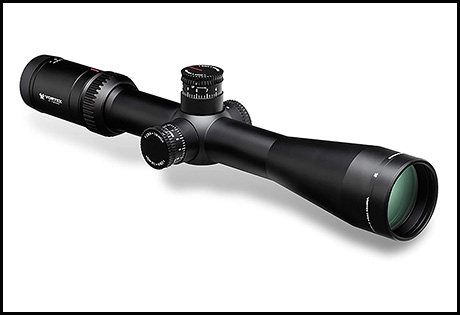
The Vortex HS-T is an exceptional riflescope of military-grade masterful construction. Manufactured of 1-piece consisting of aluminum, aircraft-grade is the 30mm exterior tube.
If you are wondering what the HS-T stands for in the name, it’s hunting, shooting and tactical. It is a rifle scope that is a jack of all trades.
With a splendid optical arrangement, the target acquisition is rapid and action smooth each single shot taken. At 6x, 4-inch liberal eye relief and eye relief of 3 inches at 24x is provided.
At a magnification of 24x, positioning the eye on the ocular is awkward as the exit diameter was smaller. An unblemished image is presented without visible distortion at the edges.
The VMR-1 serves its cause admirably. The crosshairs yield both MRAD and MOA with the turrets matching the chosen reticle’s nature.
The optics top their class. The multi-coated XR lenses are fully coated. The glass construction improves the light transmission, rendering superior visibility in many lighting conditions. The coating that is anti-reflective on the many layers nullifies the glare to which the glass-to-air surfaces are subject.
Side focus adjustments empower you to view a perfect image as also void parallax when firing.
We immediately spotted that the mounting was a bit sloppy as the zero returning to zero could pose a minor problem, but was easily rectified by shims on the elevation adjustment turret.
The construction is solid, the optics enviable. Another facet we found worthwhile was the time taken to focus and let off a shot; not keep fiddling around trying to get the adjustments right while your quarry by which time your quarry is in the next borough.
Specifications
- The diameter of Objective lens: 50 mm
- Magnification of scope: 6-24x
- Eye Relief of scope: 4 inch
- Weight of scope: 22.6 ounce
- Material of scope: Aluminum Aircraft-grade
- Adjustment Range of scope: 65 MOA
- Focus Range of scope: 50 yards up to infinity
- Life of battery: 150 hours
Pros
- Easily readable dials
- Solid construction
- Practical Reticle
- Eye relief is generous
- Glass clarity excellent
Cons
- Expensive
- Magnification adjustment stiff
Our Verdict
The HS-T is a great scope for hunting and target practice. It is peerless for medium and long-range quarry when correct use of settings is apt. The product comes with VIP warranty!
Whether you are getting your feet wet or are a professional, you will have a product that is one superlative optic with adequate eye relief.
Getting the hang of the second reticle is your ticket to not keeping you back. It’s also reasonably priced under $1000, so if you’re searching for the best long range scope under 1000, this is a great place to start.
3 Trijicon ACOG 3.5×35
![]()
There are many rifles using the 308 cartridges and if your fancy is short-range, this riflescope is your dream that has come true. As a close-quarter scope, it is low on magnification yet amply makes up with other aspects.
Constructed with the solidness of a Patton tank with. 7075-T6 which is an alloy of forged aircraft-grade aluminum of which the body is made. It is virtually indestructible.
To elaborate on the aspect of magnification, it is a 3.5x 35 scope which means the magnification is meager. The objective is modest.
The Trijicon ACOG’s field vision at 100 yards is 29 feet which is quite admirable. With a 2.4 inches eye relief that is definitely on the lower side although AR-rifles have a little problem with the arrangement.
Using a rifle with bolt action is a real test. The scope being short of a length and moreover with the distance of the eye relief, the shooter has to lean a good deal forward so as to sight in well.
There are reticles of many sorts that the Trijicon matches well with. The particular type we evaluated, had a Chevron reticle that was illuminated. We totally loved it.
The possibility, by day, is via fiber optics and in darkness through tritium. There is no call for manual adjustments. The tritium illuminating system can self-adjust depending on conditions.
The makers claim that this reticle compensates bullet drop till 850 yards. We hold that this is a tall claim taking into account anyone shooting so far with this scope.
Comparing the Trijicon ACOG and the Viper HS-T, both are constructed robustly and perhaps, are some of the most powerful models so far.
The first is ideal for hunting, tactical, and shooting whereas the Trijicon is a weapon more for tactical purposes. Its beauty is the reticle illumination whereas the Viper’s optics are peerless.
Specifications
- The diameter of the Objective lens: 35 mm
- Magnification of scope: 3.5x
- Eye Relief of scope: 2.4 inch
- Weight of scope: 14 oz.
- Material of scope: Forged Aluminum
- Caliber os scope: .223 Remington
- Illumination type: Tritium, Fiber optic
Pros
- Illuminated reticle
- Great for 50-100 yards
- Extremely sturdy construction
- Warranty of 1-year provided
- Excellent eye relief
Cons
- Pricey
- Reduced adjustability
Our Verdict
This is a scope that has seen action and coveted to own one. The Trijicon scope has engaged in more adverse and combat conditions than most scopes out there. If you’re a hunter on the lookout for the best rifle scope for 1000 yards, you should try this one out.
This is also one of the most expensive rifle scopes on our list. But for a premium scope that is durable and worth every cent, your search ends here.
4 Vortex Optics Diamondback Tactical First Focal Plane
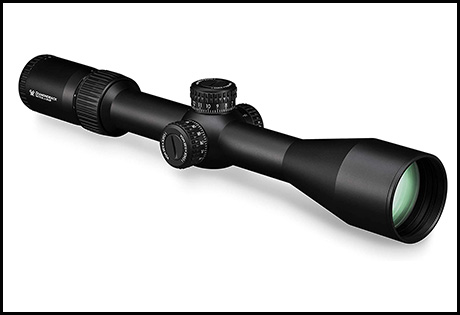
We are Vortex fans for all the right reasons. High-quality optics that are affordable are tough to beat. They are indestructible, are backed by competitive and supportive customer support and an invincible warranty. We can only roll our eyes.
The best First Focal Plane Scope is how we rate this scope and we are bang on. An FFP is what is preferred widely as in a dynamic situation such as hunting or competition, the reticle remains constant throughout the magnification range.
The Diamondback may be missing the bells and whistles of the more premium scopes but is armed superbly for solid performance.
It has fully coated optics for a crystal clear picture and an image that is anti-selective; a one-piece durable construction and argon purging makes it weatherproof.
A fast-focus eyepiece, a precision glider erection system gives you flawless experience under the hardest conditions; truly visionary. It is a lightweight scope.
We nosed around a bit and where. The delight at this scope was unanimous. Zero held like a charm. The reticle has an issue against white backgrounds at 300 yards. No one mentioned the random defects that are bound to creep in.
Cross-checking with Vortex we were assured that such problems are taken care of immediately and what’s there not to believe them in the first place as they give the best VIP guarantee out there.
After putting the Diamondback through its paces, we are totally satisfied. At 16x, the clarity begins to dip a bit. Darker targets at low light seem to present a problem of clarity.
Diamondback is not the only scope we are going gaga over. The Viper PST and the Nikon Prostaff are breathing down its neck both having hit a home run with matching features and tags.
Specifications
- Magnification: 4-16x
- Objective: 44mm
- Eye relief: 3.1 inch
- Field of view/ 100 yards: 32.4-11.3 feet
- Parallax setting: 100 yards factory set
- Length: 12 inches
- Weight: 14.6 oz.
- Adjustment graduation: ¼ MOA
- Reticle: BDC
Pros
- Affordable
- Options of illuminated BDC reticle
- Zero resettable turrets
- Transferable lifetime warranty
Cons
- On higher scope magnifications, images could be better
- Turrets do not track as well as they should
Our Verdict
The Diamondback is undoubtedly high-performance, its perfection all the way. The parameters 4-12x 40 are in the right slot. What’s more, it’s an FFP with a fast focus adjustment.
It’s an American favorite optic brand. When hunters and shooters want to get it exactly right, they have hit the hammer on the nail’s head every time. So the running theme here is. “Do it right the first time, every time.”
5 Mueller Target Rifle Scope 8-32 x 44mm
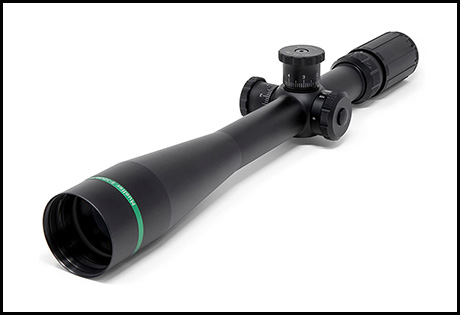
The Mueller Target Rifle Scope is a budget-friendly scope aimed at those starting off. Such a customer is looking for something inexpensive, needlessly sophisticated and his only interest is in getting that clean long shot.
This scope has good eye relief and a magnification of 8-32x which will work like a charm. The objective of 44mm and an eyepiece is fast focus adjustment which is really cool for rapid target adjustment and the clarity of the eyepiece would supersede those found on many expensive scopes.
The target dot and the micro-fine crosshair makes it elementary for the shooter to handle. The scope comes with a limited lifetime warranty.
We observed that the crosshairs in the Mildot version were a bit thicker. Elevation adjustment, windage, and clarity were all flawless, the only black mark was its weight that was on the higher side. Also, adjustment clicks were hard to feel.
Most lenses get dark and fuzzy at 24x but surprisingly, the Mueller can go up to 32x before this effect kicks in. The side focus knob makes focusing child’s play. This is the only scope that is ? MOA per click.
You will probably have a good laugh at the price which is pegged at below $300. Long-range scopes don’t come cheaper!
Specifications
- Magnification: 8-32x
- Objective: 44mm
- Eye relief: 3.2 inch
- Field of view/ 100 yards: 2.5-9.3 feet
- Parallax setting: 10 yards to infinity
- Length: 16.25 inches
- Weight: 26 oz.
- Adjustment graduation: ? MOA
- Reticle: Target Dot
Pros
- High 8-32x magnification
- 4-inch eye relief
- Windage/Elevation adjustment range of 40 inches at 100 yards
- Robust construction
Cons
- Handicapped at short distances
- 44mm objective relatively small
Our Verdict
What we liked about Mueller is the ‘what you see is what you get’ approach. It is a beginner’s scope and as such, this is most befitting instead of confusing the shooter.
The price is much within reach and the robust construction is another must as initially it is bound to be bumped around a bit. If you’re a beginner, this can be a great option for you first long-range big game scope.
6 Nikon Black FX1000
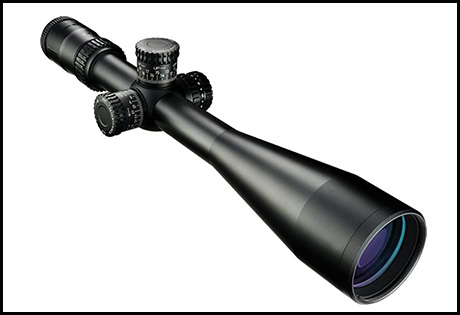
Without any mention of Nikon, any list is incomplete. This product, the Nikon Black embraces the brand standing totally. The optical prowess is enhanced with a First Focal Plane.
The FX-MOA reticle came into being expressly for this purpose. Provision of the necessary adjustments for ranging, holdover, and windage corrections have also been addressed.
Side controls for illumination render 10 different intensity settings which are tuned to automatically shut off when nonoperative to save on the battery.
We believe the high features of the Nikon Black are the high-speed turrets. These turrets operate at a ¼ MOA per click. An immediate zero stop is another feature provided so that reverting back to zero is almost instantaneous.
The parallax adjuster is side-mounted and does a daunting task of completely abolishing parallax.
Moisture is denied entry into the optics by the lens seals and the housing of nitrogen provides the ultimate protection against thermal shock. Only premium quality materials have gone into its construction so it serves you well for years.
We do admit that the name Nikon lends itself to bias like a Ferrari or a BMW but we stand committed. If we go through the above description and highlights of the Nikon Black, one thing is evident; it has not been overpowered by features that are burdensome and have focused entirely on putting the best into what is essential.
For us, the outstanding feature is the reticle; simple, uncluttered and useful. The glass, however, appeared to be mediocre. The clicks too appeared a bit mushy to us. In a word, a great scope for a remarkable price at around $500.
We could not help calling in the Diamondback as a comparison with the Nikon Black. The similarities are quite startling; FFP, fast focus, great optics, budget-friendly and more. The main difference is the reticle. This is where we believe the Nikon Black edges forward.
Specifications
- Magnification: 6-24x
- Objective: 50mm
- Eye relief: 3.6-4.0 inches
- Length: 15.2 inches
- Weight: 24.5 oz.
- Adjustment graduation: 1/10 MOA
- Reticle: FX-MRAD
Pros
- Black FX-MOA reticle
- High-speed turrets
- Rugged craftsmanship
- Illuminated reticle
- Good eye relief
Cons
- Crosshairs thick at longer ranges
Our Verdict
Nikon reportedly put in all their engineering experience to manufacture one of the best 1000 yard scopes that today’s market has to offer. The scope line was to target precision rifle shooters and action marksmen.
Etched into the glass, the reticles are available in both X-MOA and X-MRAD both being tactical-style reticles – all the more reason to go in for one when contemplating long-range 1000 yard shots.
Again, if you are searching for the best scope for 6.5 grendel, you better get Nikon’s P-Tactical model for better adjustments.
7 Vortex Optics Viper PST Gen II First Focal Plane
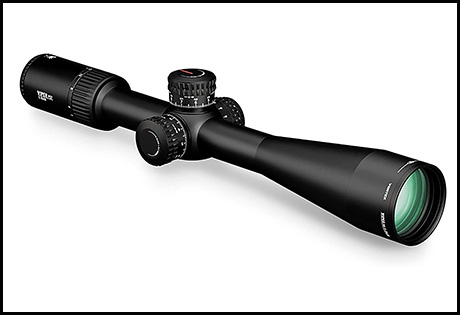
The Viper PST Gen II riflescope is another superb scope from Vortex, a pioneer in optics.
The first focal plane reticle is illuminated and the tactical style turrets make it a cinch to recompense bullet drop and wind drift at long ranges. To halt the turret from misaligning below the original zero after a compensated long-range shot a Rapid Return Zero (RZR) is incorporated.
Extra-low dispersion glass boosts color trueness and resolution. This gives you crisp and sharp images. To heighten light transmission, all air to glass interfaces are fully multi-coated with anti-reflective coatings.
The exterior of the lens surface features Vortex’s patented ultra-hard ArmorTek coating to safeguard against oil, dirt, and scratches. The body is of 1-piece, 30mm tube of aircraft-grade aluminum.
A durable hard-anodized low glare matte finish is spread to promote concealment. The Viper PST Gen II scope is O-ring sealed and argon-gas purged for that cent percent waterproof and fog proof dependability.
The EBR-2C MOA reticle is for calculating windage and elevation compensation. This riflescope is covered by a VIP Unconditional Lifetime Warranty.
Vortex Optics is our all-time fav. We wish to chip in with our experience. The bad news first; zero does not hold. The manufacturer made adjustments and all was hunky-dory.
The reticle illumination for daytime does not quite cut it. It’s all up from here, especially the lens that we simply felt was a sublime piece of optical engineering.
We put the Viper PST Gen II and The Burris XTR under the magnifying glass.
From the optical properties, the PST Gen II ran away with an overall much higher score. The Vortex also scores in the field of view. Another significant difference is that the parallax is adjustable on the PST from 25 yards to infinity, the XTR 50 yards to infinity.
We give it to the Viper PST Gen II hands down. This is in the heavier range of $700 to $1300 and has attracted its fair share of reviews.
Specifications
- Magnification: 5-25x
- Objective: 50mm
- Eye relief: 3.4 inches
- Length: 16 inches
- Weight: 31.2 oz.
- Adjustment graduation: ¼ MOA
- Reticle: EBR-2C MOA
- Field of view/ 100 yards: 24.1-4.8 feet
- Parallax setting: 25 yards to infinity
Pros
- Premium quality glass
- Multiple illumination settings
- Locking mechanism provided
- Exceptional scope protection
- First Focal Plane reticle
Cons
- Short eye relief
Our Verdict
Vortex over the years has built up a name as a manufacturer of quality optics. The Viper PST Gen II is no different. If you want advanced features, performance, and durability in your scope, this one can easily be one of the best long range scopes under 1000 USD.
Extra low-dispersion glass, Armortek coating, and many safeguards have resulted in a supremely crafted optic. True, it is priced on the heavier side, but for a scope of this caliber, it is justified.
8 Primary Arms Classic Series 4-16x44mm SFP
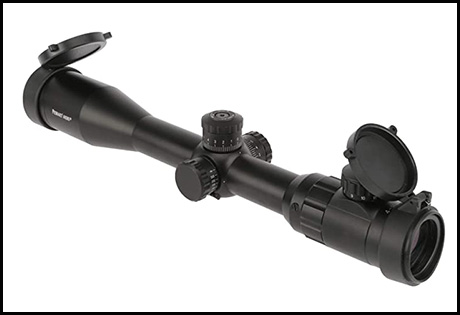
The Primary Arms 4-16 is the quantum of magnification used in this scope teamed with a 44mm objective lens. This is a balanced arrangement. The larger the objective, the brighter your view.
The illuminated Mil-dot reticle follows that a Mil-dot reticle or crosshairs with dots are used in lieu of a solid line. Allowing for windage or windage without having to actually adjust the actual dots are a handy feature of these dots. The scope has 11 settings for brightness.
They are waterproofed by nitrogen purging so neither is fogging up an issue and internal rusting is done away with.
¼ MOA locking resettable turrets. This shifts the point of impact ¼ inch at 100 yards by the click of the dial. Since they are locking, you need to pull up the dial in order to adjust.
A one-year warranty comes with the scope.
We observed that with more magnification, a certain amount of distortion occurred when swapping from the naked eye to the scope. This took longer to focus.
We tested the scope for illumination on a very bright sunny day and in full daylight, the illumination was visible. Overall with these specs, this scope makes for a mighty impressive one.
Better still, the price tag is reasonably paltry at around $165. Several options are presented to you on the first purchase; upgrading covers and mounting styles. The customer service is brilliant.
The Mueller is the only comparable option here with the Primary Arms, the primary similarity being the reticles; both are Mil-dots. Mueller has a lot more power and the objective is quite the same.
The Mueller and the Primary Arms are both more or less barebone without too many frills concentrating more on giving you a comfortable, easy to use and a durable scope. We are suitably impressed with both.
Specifications
- Magnification: 4-16x
- Objective: 44mm
- Eye relief: 4 inch
- Length: 14.75 inches
- Adjustment gradation: ¼ MOA
- Reticle: Illuminated Mil-Dot
Pros
- Mil-dot reticle illuminated
- Fully multi-coated optics
- Windage and elevation turrets easily adjustable
- Durable construction, waterproof and shockproof
Cons
- Insufficient eye relief
Our Verdict
This scope is well put together, durable and its performance is guaranteed. If you want a high-quality scope without breaking your bank, you can consider this as one of the best scope for 1000 yards.
It contains all the core features of a performer without any needless bells and whistles.
9 Nikon 16384 X1000 Matte Illuminated x-MRAD Reticle
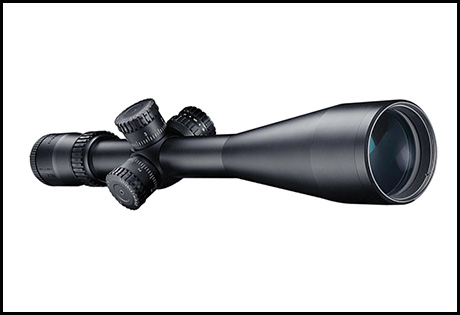
Long-range shooting is what the Nikon new black X1000 is meant and designed for. The magnification range is variable from 6-24x with an objective of 50mm. These are second focal plane scopes.
Nikon tosses in two reticle choices; the X-MOA or the mil-based X-MRAD. The reticles are glass etched so they won’t break like cheap wire crosshairs. Being etched in glass implies bang-on and repeatable adjustments whether you wish to hold or tinker with elevation and wind settings.
For simple field corrections, the windage and elevation turrets are spring-loaded for instant zero resets
The Black X1000 has the side focus parallax dial so tuning on the fly is possible. The focus of the eyepiece ocular lens can be done easily. Do it against a white backdrop or the open sky. A sharp reticule means a properly focused eyepiece.
The main tube is of immense strength. Being machined from aircraft-grade aluminum and finished with a Type III hard coat anodizing.
The X1000 is a tremendous value for what it is offering. It comes with a well-designed sunshade that not only takes care of the glare but also acts as a buffer against rain so the lens remains protected from the moisture.
We were very impressed with the nice touch to the reticle. The illumination is controlled by a knurled outer knob. The reticle can be impressed on the exact spot of the target or turned off. We found the hash marks on the turrets slightly misaligned but it really is not a big deal.
We decided to compare the two Nikons, the FX-1000 is an FFP, this one an SFP. The FX comes along with an immediate zero stop which is pretty functional. Other than these, there is nothing to set the siblings apart by much.
Specifications
- Magnification: 6-24x
- Objective: 50mm
- Eye relief: 3.5-4.0 inches
- Length: 15.2 inches
- Weight: 25 oz
- Adjustment gradation: 0.1 MRAD
- Reticle: SFP X-MRAD Illuminated
- Field of view/ 100 yards: 18-4-5 feet
- Parallax setting: 50 yards to infinity
Pros
- Great for inclement weather
- Precise and consistent turrets
- Plenty of eye relief
- Multi-Coated lens
Cons
- Illumination controls difficult in the beginning
Our Verdict
Nikon is in a class of its own. They are deeply involved in bettering their products delivering to the end-user a scope that is easy to use, efficient for its purpose, and a joy to be the owner of. If you long for
reliability and quality, this can be the best rifle scope for 500 yards or longer shooting ranges.
The optics, robustness, parallax compensation are all top-notch. The X1000 has a deft touch in the provision of two reticles that will see you through any shooting situation.
10 Burris Optics XTR II
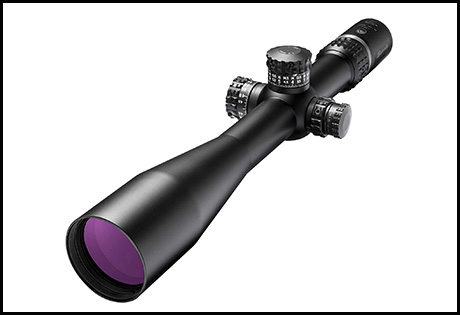
The XTR II by Burris is the highest magnification scope that Burris has launched. The back focal plane is an illuminated F-Class MOA reticle. This works wonders and covers the prey minimally as subtensions alter with zoom tuning the reticles that are ballistic.
The Burris was initially designed as a bench rest scope of inimitable accuracy and unerring precision that is a grave requirement among competition shooters. It has now gained much ground as a scope used for bringing down prairie dogs.
The XTR II illuminated reticle is one of its kind. The reticle’s sole part that illuminates is three dots. One is on the central cross intersection, the two others at 10 and the 20 MOA on the vertical post.
Even in the brightest setting, they are invisible except when ambient light conditions grow darker. This was done intentionally as this scope being a competition mode scope, the illumination needed to be kept at a minimum to avoid target obscurity.
The Burris XTR II is a massive seller as also a looming hit among shooting enthusiasts. But our opinion is that the illumination arrangement adds minimal utility. We tested by firing the XTR at 900-1000 yards and a little beyond before switching to 600 yards. Target acquisition precision was bang on and we did not miss a single shot.
The core strength of the XTR II is the optics. Beautiful. Burris has gone that extra yard by putting a lock mechanism to eliminate the constant need to zero.
Specifications
- Magnification: 8-40x
- Objective: 50mm
- Eye relief: 3.5-4.25 inches
- Length: 16.68 inches
- Weight: 31.4 oz.
- Adjustment graduation: ? MOA
- Reticle: F-Class MOA Illum. (FFP)
- Field of view/ 100 yards: 13.2-2.8 feet
- Parallax setting: 50 yards to infinity
Pros
- Versatile zoom erector system
- Multiple reticle choices
- Instant zero reset
- Locking mechanism
Cons
- Eye strain at full power
- Turrets are a little stiff
Our Verdict
For versatility, it scores top marks for the zoom selector system. The large objective lens feeds you a crisp and clear image. This is also partly due to the multi-coated lens.
The choice of different reticles is indeed a game-changer. Without batting an eyelid, we can say it’s a good value for the money.
Best Long Range Scopes– Buying Guide
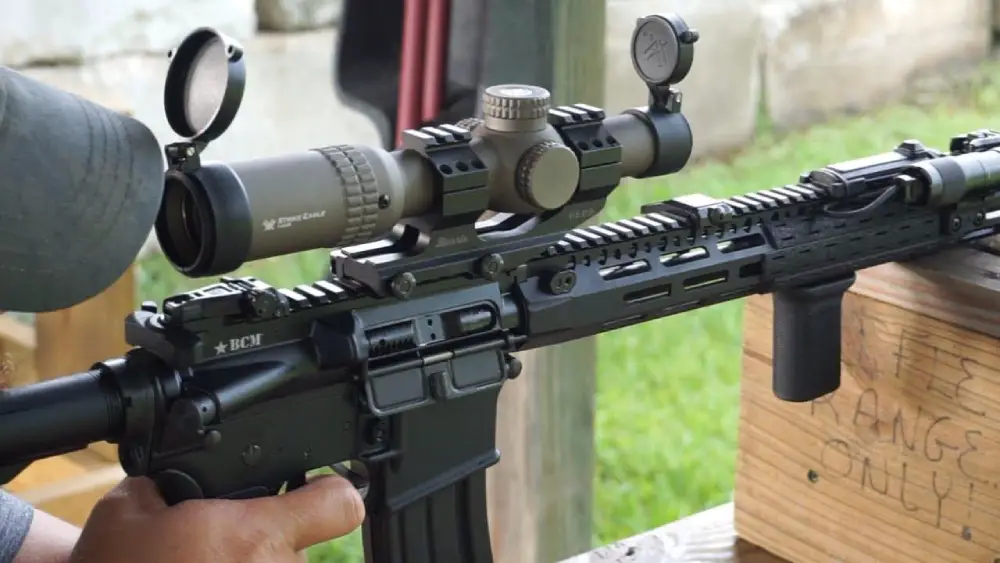
1. The Reticle
The cross-hairs in your scope or the reticle as it is also called plays a part in how you like to shoot. If your preference is shooting long distances, what is good for you is a BDC (Bullet Drop Compensator) reticle.
Millings are amalgamated into the reticles. With every shot, bullet drop, elevation, and windage factors are adjustable.
Reticles come in various kinds and you will be spoiled for choice. Your pick of the reticle is totally dependent on your shooting style and comfort. There are up to 6 types of reticles, the most common being the BDC, Mil-Dot, and Duplex.
2. Magnification
Your objective lens choice is related in part to your eyesight. 10x is sufficient for some people to pull off a great shot at a thousand yards and for others, they may need to go up to 20x.
For selecting the best scope for 1000 yards, the minimum power of 16x is a must. If you are one of those versatile shooters, greater variability is your need. A 3-25x scope should fit the bill perfectly. Let’s explore the different magnification you’ll need at different ranges.
Close Range (Up to 150 yards)
Your vision will be blurred if you use high magnification at close ranges. For the most accurate shot at under 150 yards, use a magnification of 1 to 5 or 6x power. Make sure your arrangement is right as the bullet drop won’t happen anywhere closer if the bullet is of high caliber.
Medium Range (150 – 350 yards)
This distance is classic for the .308 rifle to tackle a game that is medium to large size. The reason is elementary. A far shot carries with it the risk of injury to the animal instead of a fair kill. Ethical hunting binds you to a 6-9x magnification.
Long Range (350 yards and above)
To put this range to the test, it will be where the full power of your rifle will be utilized. .308 optics are a must when you are pushing that much ahead of 350 yards.
Make sure you choose from scopes with 24X, 25X, 32X, 40X and 50X magnification capacities. For F-Class competitions, you may need scopes with higher power capacities.
3. Objective Lens
Every scope has two lenses. The one at the rear is the eyepiece to which your eye is placed and the one at the rear is the objective which allows the light to come in. The larger the objective, the more is the light that enters giving a clearer sight picture. This is excellent in poor light where you need a clear shot.
The downside is that the larger the objective, additional weight is added by the lens system so there has to be a tradeoff between the best image quality whilst keeping the weight reasonable.
For hunting scopes, a 42mm lens will do splendidly. If you want to go get the highest range model, you should opt for March’s 80 mm scope.
4. Durability and Construction
Your scope should be both robust and durable to take its fair share of wear, knocks, thumps, raps and more. If your wish is for a scope that is durable, it should be really robust. For hunters, officers enforcing the law, and more, this achieves critical proportions.
Durability also encircles weatherproof and it can hurt if your money is wasted. To disallow ingress of moisture into the tube, nitrogen or argon purging is done and also O-ring seals on the lens affixed.
So in choosing that scope, ensure its sturdiness and durability. Aluminum alloy scopes and exterior coatings are wonderful.
5. Quality of Lens
All are aware of the paramount importance of the quality of the lens when viewing distant objects. This assumes major dimensions when it comes to long-range shooting.
A crystal clear view of your target is what you pray your scope’s lens will deliver. The diminishing of picture quality with magnification is seriously unwanted.
A clear image at high power will readily equip you with a better understanding of how your shot will be affected by the wind.
The question pops up; how do you pick a good quality lens? One way to do it is to evaluate light transmission. For this, you will have to compare different brands side-by-side which is an onerous task.
The other method is to go in for manufacturers who are known for their expertise in lens manufacturers like Nikon, Zeiss, Trijicon, and more. However, you can also choose one from our recommendations.
6. Precise Adjustment Turrets
These are indispensable for extreme range shooting. If you have set up the combination of rifle and scope for 1000 yds, making elaborate adjustments for that range may be unnecessary.
But if you are attempting a shot at a much-reduced range or stretching the shot over 1000 yards without a target turret, you would have to aim so high that the target will be outside your field of vision.
Hitting the target is an altogether different matter dictated by luck.
7. Objective Lens Size
Most riflescopes have an objective lens of diameters from 32mm to 44mm.
For hunting in low light conditions, increased light gathering capacity of an objective lens that is larger may be preferred. For such situations, a 50mm to 56mm objective is preferred.
8. Main Tube Size
The size of the tube plays an important role in shooting at long-ranges. Ample adjustability from the turrets is a necessity. A common misconception is that a larger tube gathers more light.
This is false. It allows for larger lenses that offer a better image quality but not by more light gathering. Thicker tubes offer greater durability and also allow more space inside for additional adjustments.
Tubes are generally of 1-inch, 30mm, 34mm and 56 mm diameters.
9. Parallax
Parallax poses little issues among short to mid-range scopes as the scopes in this range are already adjusted for parallax. However, on a long-range scope, parallax constantly has to be paid attention to.
When the target and the reticle are not in the same focal length, parallax results. What happens is that the eyes are in motion relative to the scope whereas the reticle will sight over your target.
10. Elevation Adjustment
With distance, there will be an increase in bullet drop. The greater the need for elevation adjustment the further the target is away. The same goes for wind and parallax.
The external knobs you see raised at the eyeball on the top and to the right of scope are the target turrets. These are used for windage and elevation. Their purpose is to change the bullet impact by raising, moving sideways, or lowering the reticle crosshairs for devastating true aim.
11. MOA vs Mil
On the reticle of a long-range scope, two of the most common markings are MOA and the Mil. The reticle most favored by Americans is the MOA (Minute of Angle) reticle.
The difference between MOA and Mil is that an MOA is 1.047 inches at 100 yards and a Mil is 3.6 inches at 100 yards. The preference is because it is easier to make mental computations using MOA. Which to choose is a matter of personal choice.
However, a Mil scope has greater accuracy over long distances. Irrespective of what you choose, make sure the markings on the reticle and the turret are the same or you will be in hot soup.
12. Eye Box
To get an idea as to what an eye box is, consider the area behind the scope as a box. A box is 3-dimensional. The confines of this box are where your eye can move up, down, left, right, forward, backward and yet the eye should be able to see the reticle and the target.
13. Tracking Test
Scope Tracking is the potential of a scope’s mechanical elevation (up and down) or windage (left and right) adjustments to position the crosshairs precisely as intended by the shooter.
The turret adjustment knobs are calibrated to move at finite precise intervals. Say, like the second hand of your watch. Each of these intervals or clicks should be the same. The calibration is in MOA or Mils.
If your scope has ¼ MOA adjustments, 4 clicks equal 1 MOA which is 1 inch at 100 yards (as we have seen before), 2 inches at 200 yards and so on. If your bullet is striking 1 inch high at 100 yards, 4 clicks in the right direction will put it on the bullseye.
14. Budget and Warranty
A well-defined warranty is really quite useful that the best scopes for 1000 yards often come with. It, of course, serves the purpose of getting the best service for the product you have purchased, not to mention your money’s worth.
Check the details of the warranty before making a purchase, including the fine print. Approach the manufacturers directly as different warranty schemes may apply to distributors
Considering your rifle and the job you require it, you are looking at $300-$1300. A pretty decent scope will come for under $500. Some people hold the view that the cost of the scope should match that of your rifle.
Long Range Shooting Tips
Data Collection
Whenever on the range collect data on your rifle. Try and record data with every shot so you know how your gun will behave in different conditions. We will use this DOPE (Data of Previous Engagements) book for reference prior to any shot.
Dirty Shooting
Shooting a dirty gun is what snipers prefer with sniper scopes. They only clean their rifles every 200 or 300 rounds.
Squeeze During the Pause
Shoot on the respiratory path at exhalation. Take three deep breaths and then exhale. The following 1-3 seconds is when you want to take that shot.
Follow Through
A slow, steady, squeeze on the trigger is the way to go. Certainly don’t jerk. An important thing most are unaware of is that even after the shot breaks, keep squeezing the trigger to the end before releasing it gently; the follow-through.
Set A Higher Stand for Zero
Many hunters are quite happy with a gun not quite zeroed. The litmus test for a sniper to reckon if his gun is zeroed is to put in 3 consecutive rounds within a square inch. Don’t settle for less.
Stay Out of Sight
Reconnaissance and intel gathering is a primary role on the battlefield. How well you are camouflaged reflects on this.
Pay Heed to The Wind
The wind is never constant. For super snipers, the all-pervading assumption is a wind at two-thirds of the distance to the target. There will be multiple shifts of directions and wind intensities. You need to recognize this and make due adjustments.
Know Your Bullet
The average hunter will be making the use of some ballistic-tip ammo. These bullets will sacrifice ammunition. You will need to subject your ammo to some testing and figure out what’s best for your firearm.
Also remember you can’t make a lot out of putting a 1000-yard scope on an AR 10 carbine . Choose your rifle wisely.
Get Smart from The Kick
If you are behind a .308 or some other firearm of an equivalent recoil, the kick of the gun is your best teacher to tell you where you are going wrong. Every time a sniper lets off around, he expects the gun to return straight back to him. The scope should fall right back on target. You’ve got it right then.
Dial It, Mil It
For taking long shots, there are two ways. For swift encounters, a 500-yard zero is used and the reticle referenced for the holdover or hold under.
However, if it is a 1000 yard shot you want to take and have the time, consult your DOPE and dial-in your 1000-yard range for a first-round kill.
Scope Cleaning & Maintenance Tips
Here are some tips for taking good care of your scope –
General Measures
- Go through the Manual Instructions
- Have ready at hand the materials required
- Do not touch the scope lenses as fingerprints and oils will be transported on them
- Do not attempt to buff away a scratch from the lens. It will damage the lens
- Never use saliva to clean the lens
- Never use compressed air
- Do not use paper towels ordinary cleaning cloths or facial tissues
- Never use window cleaner
- In cold climates do not breathe on the lens
- Replace all caps when the scope is not in use
- An airbrush is recommended for lens cleaning instead of blowing
- Use microfiber lens cloth for cleaning
- Special Lens Cleaning Solution is recommended for lens cleaning
Precautions & Instructions
- Open objective and ocular lens covers and examine minutely for dust and gunk
- Remove as much of foul matter as possible with a soft bristle brush or an airbrush
- Use a lens pen or special lens cleaning solution to eliminate smudges and fingerprints
- Apply the lens cleaning solution on the microfiber cloth and use to clean
- Start from the center of the lens moving in a spiraling motion. Discard used tissues
- The lens should be inspected for dust spots or streaks
- If any leftover residue or streaks are observed, repeat the process again
- Close objective and ocular lens covers. Your lens is as good as new now
FAQs
Q. 1: Is 16x enough for 1000 yards?
Ans. 10x is the best choice. Yes 16x is also great for long-range shooting except for the fact that the mirage effect creeps in. At higher magnification, the mirage effect gets more noticable.
Q. 2: What caliber is best for 1000 yards?
Ans. There is a whole lot to choose from depending on your intentions. I personally prefer the .338 Lapua and a good scope for this cartridge. From options of grain weight, price, and performance at a long-range it is the best. It holds an outstanding record among military circles, snipers, and so on.
Q. 3: What reticle is best for long-distance shooting?
Ans. A reticle that has as one of its features MIL or MOA markings is great. For long-distance shooting, it boils down to compensate for bullet drop and the effects of wind. For the best scope for 500 to 1000 yards, we recommend a Mil-dot scope in the first focal plane.
Q. 4: Does the length of a scope matter?
Ans. Yes. A longer scope typically provides a wider field of view and can be easier to use at longer distances, while a shorter scope may be more compact and easier to handle in close quarters or in dense brush. Additionally, the length of a rifle scope can affect its overall weight and balance, which can impact the shooter’s comfort and accuracy.
Q. 5: How long can a scope last?
Ans. If you store your scope in a cool dry area, away from direct heat or sunlight, the average quality scope will last for about 3 years. However, the time period can be extended for high-end scopes, especially if you take good care of it.
Q. 6: Does cold weather affect scopes?
Ans. Yes. Changes in temperature can cause metal to expand or contract, which can cause the internal mechanisms of the scope to shift slightly. Also, when the temperature drops, moisture in the air can condense on the lenses, which can cause fogging or frost to form on the surface of the lens.

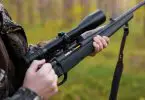
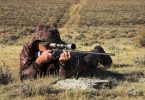

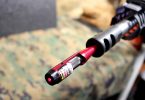

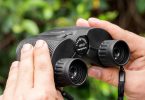

Leave a Comment